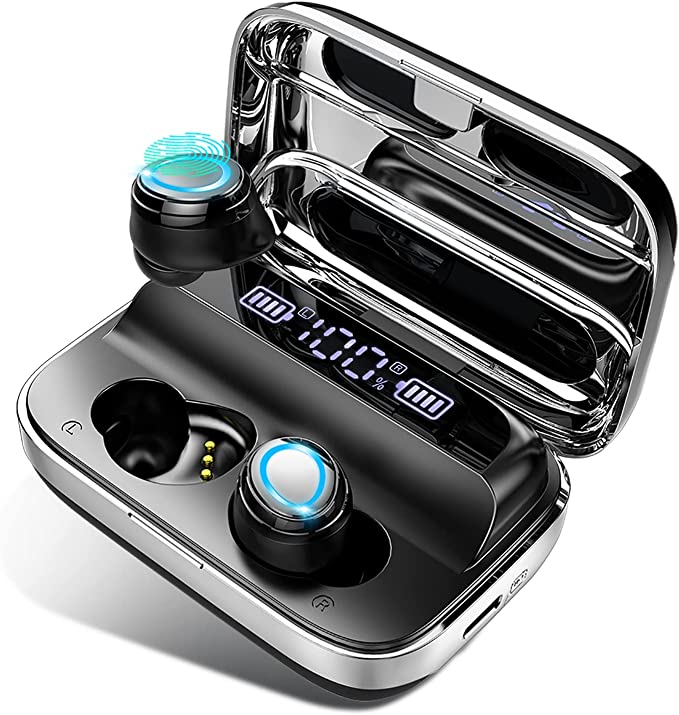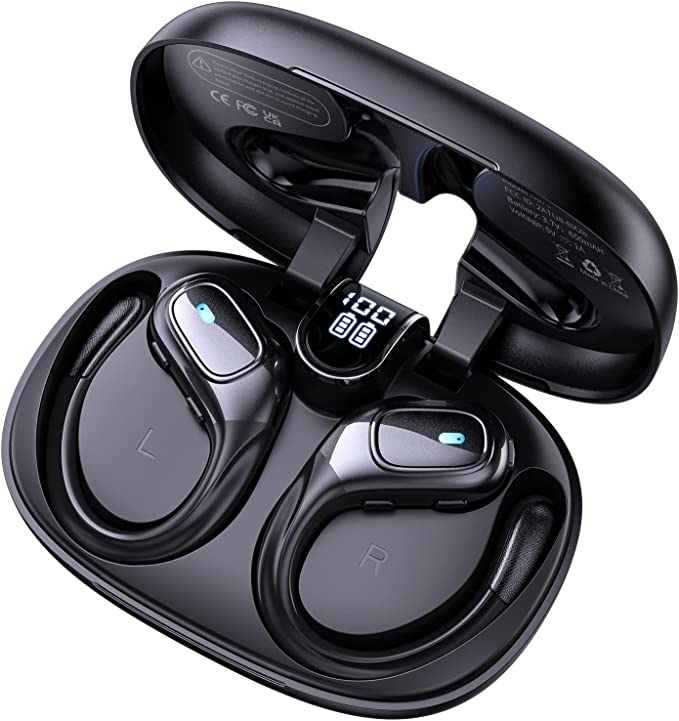We live in an era increasingly untethered. From our phones to our music, the dream of seamless wireless convenience is potent. True wireless earbuds, tiny marvels promising freedom from tangled cords, embody this dream perhaps more than any other gadget. Pop them in, and instantly, your personal soundscape comes alive – music, podcasts, calls, all floating untethered through the air.
Yet, sometimes the magic falters. Connections drop mid-sentence, batteries die at the most inconvenient moments, and the promise of pristine audio gets muddied by the realities of a noisy world or an unexpected downpour. What separates a frustrating experience from a truly seamless one often lies beneath the sleek plastic shell, in the intricate dance of technology.
Let’s embark on a journey “under the hood.” Using the specifications described for a common example, the Motast I09 wireless earbuds, as our guide, we’ll explore the science and engineering principles that make these miniature powerhouses tick. This isn’t just about one product; it’s about understanding the fundamental technologies – Bluetooth, battery management, audio processing, waterproofing – that shape your everyday wireless audio experience. Prepare to decode the invisible signals and appreciate the symphony of science playing out in your ears.

The Invisible Handshake: Making Friends with Bluetooth 5.3
The very foundation of “wireless” is, of course, the connection itself. Most earbuds today rely on Bluetooth, a short-range radio technology that acts like an invisible, digital handshake between your earbuds and your phone or other device. You might be surprised to learn its name has rather noble, ancient roots, borrowed from Harald Bluetooth, a Viking king famed for uniting Danish tribes – just as the technology aims to unite different devices.
The Motast I09 specifications mention Bluetooth 5.3. Like any evolving technology, Bluetooth versions bring improvements. While the specifics can get technical, the Bluetooth Special Interest Group (SIG), the custodians of the standard, outlines that versions like 5.3 generally focus on enhancing:
- Stability and Reliability: Think of early Bluetooth like a crowded room where everyone’s trying to talk at once. Newer versions employ smarter strategies to manage the radio waves, reducing interference and making connections less prone to dropping. The product information for the i09 suggests a stable connection range of up to 15 meters and quick 2-second pairing after initial setup, reflecting these aims. It’s like upgrading from that noisy room to a well-moderated conference call – fewer interruptions, clearer communication.
- Power Efficiency: Sending and receiving radio signals takes energy. Bluetooth 5.3 incorporates features designed to let devices sip power more intelligently, especially when idle or transmitting small amounts of data. This contributes directly to how long your earbuds can last on a single charge.
Ultimately, a robust Bluetooth connection is the unsung hero of a good wireless experience. It’s the reliable foundation upon which everything else – sound quality, call clarity, sheer convenience – is built. Fewer dropouts during your favorite song’s crescendo or that crucial business call? That’s the goal of advancements like Bluetooth 5.3.

The Marathon Runner’s Secret: Anatomy of 140-Hour Playtime
One specification that often jumps out is total playtime, with the Motast i09 materials claiming a remarkable 140 hours. How can such tiny earpieces hold so much power? The secret lies not just in the buds themselves, but in their partnership with the charging case – an ingenious ecosystem designed for endurance.
It works like an energy relay race:
- The Sprinters (Earbuds): Each earbud houses a small battery. The i09 documentation states these are Lithium Polymer types (common in portable electronics due to their relatively high energy density for their weight and size) and provide about 6 hours of playback per charge. They are designed for short, intense bursts of activity.
- The Support Crew (Charging Case): This case isn’t just a storage box; it’s a mobile power bank. According to the provided information, it holds enough energy to fully recharge the earbuds approximately 23 times. Do the math (23 recharges * 6 hours + the initial 6 hours), and you land right around that impressive 140-hour total figure. The case acts as a portable energy reservoir, replenishing the earbuds whenever they’re docked.
- The Pit Stop (Charging the Case): Eventually, the case itself needs refueling. The presence of a USB-C port is significant. This modern standard offers a user-friendly reversible connector (no more fumbling to plug it in the right way) and often supports faster charging speeds compared to older micro-USB ports. The i09 specs claim the case can be fully recharged in just 1.5 hours.
This dual-battery strategy brilliantly solves the size constraint of earbuds. It offers the freedom of long listening sessions from the buds, backed by the massive endurance of the case. For users, this translates to significantly less “charger anxiety.” Imagine heading out for a long weekend trip or facing a week of commutes knowing your earbuds likely have enough power for the entire duration, tucked away in their portable power station.

Sculpting Your Personal Soundscape: Fidelity, Clarity, and the Nuances of Noise
Beyond staying connected and powered up, the core purpose of earbuds is delivering sound. The Motast i09 description highlights “HiFi Stereo Sound” and “DSR lossless HD rendering technology,” aiming for high-quality audio with “crystal crisp treble.” Let’s break down what contributes to your auditory world.
- The Foundation: Stereo Sound: This is fundamental. Stereo uses two separate audio channels (left and right) to create an illusion of space and directionality, making music feel more immersive and lifelike compared to single-channel mono sound.
- The Goal: “HD Audio”: Terms like “HD Rendering” (with potentially proprietary labels like “DSR”) generally signify an aspiration towards higher audio fidelity. The goal is to reproduce the original sound recording as accurately as possible, preserving details across the frequency spectrum – from deep bass to clear highs (“crystal crisp treble,” as the description puts it). This often involves sophisticated digital signal processing (DSP) within the earbuds to interpret the audio data stream and translate it into sound waves via the tiny internal speakers (drivers). While specific marketing terms can be murky, the underlying aim is a richer, more detailed listening experience.
Now, let’s tackle the ever-present challenge: noise. The i09 mentions “CVC 8.0 Noise Cancelling,” which requires careful clarification.
- The Noise Conundrum – Part 1 (Making YOUR Voice Clearer): Demystifying CVC 8.0
This is crucial: CVC stands for Clear Voice Capture, a technology often associated with Qualcomm chips. Its primary job is not to make the world around you quieter. Instead, CVC 8.0 focuses on your microphone’s input. It uses algorithms to identify your voice and suppress ambient sounds picked up by the microphones while you’re on a phone call. Think of it as giving your microphone “tunnel vision” – it helps the person on the other end of the line hear you more clearly, filtering out some of the surrounding street noise or coffee shop chatter. It’s about call clarity for your listener, not active noise cancellation (ANC) for you. - The Noise Conundrum – Part 2 (Making YOUR World Quieter): The Power of a Good Seal
So, how do you get a quieter listening experience for yourself? With in-ear buds like the i09, the main factor is Passive Noise Isolation. This relies purely on the physical barrier created by the earbud sealing your ear canal. A snug, comfortable fit (achieved by selecting the right size silicone ear tips – the i09 materials state S, M, and L sizes are included) acts like a well-fitting earplug, naturally blocking out a significant portion of external ambient noise. This physical seal is also vital for good bass response, as it prevents sound leakage.
Understanding this distinction is key: CVC improves call clarity for others, while a good physical fit (passive isolation) helps create a more immersive and focused listening bubble for you.

Braving the Elements: What IP7 Waterproofing Really Tells You
Life happens. Workouts get sweaty, commutes encounter rain, and accidental fumbles near water are always possible. This is where durability ratings like the Motast i09’s claimed IP7 rating come into play. But what does “IP7” actually mean?
“IP” stands for Ingress Protection, and it’s part of an international standard (IEC 60529) that classifies how resistant a device’s enclosure is to intrusion from solids (like dust) and liquids (like water). The rating consists of two numbers:
- The first digit relates to solid particle protection (e.g., dust). Sometimes you’ll see an ‘X’ here if it’s not rated for solids, like IPX7. The i09 is listed as IP7, which implies the first digit isn’t specified or emphasized in the marketing, focusing instead on water resistance.
- The second digit relates to liquid protection. This is where the ‘7’ in IP7 matters.
An IPX7 rating (or IP7, focusing on the liquid aspect) specifically means the device is protected against the effects of temporary immersion in water. The standard defines this under specific test conditions: submersion in up to 1 meter (approximately 3.3 feet) of fresh water for up to 30 minutes. The product description mentions factors like a “multi-process design headphone body” and “nano-coating technology” as contributing to this resistance.
It’s vital to understand the limitations:
* IPX7 does not mean the earbuds are suitable for swimming. Continuous immersion, water pressure at depth, and pool chemicals are beyond the scope of this rating.
* It doesn’t guarantee protection against high-pressure water jets or steam.
* The tests are typically done in fresh water; saltwater can be more corrosive.
Think of IP7 like being able to confidently hold your breath and dip underwater briefly, not becoming an aquatic creature. For earbuds, it provides peace of mind that they can likely withstand heavy sweat during exercise, being caught in the rain, or even an accidental drop into a sink or puddle, provided they are retrieved quickly and dried properly.
Command at Your Fingertips: Touch, Talk, and Know Your Power
In the quest for seamlessness, how we interact with our earbuds matters. Many modern designs, including the Motast i09 based on its description, utilize “Smart Touch Controls.” This usually relies on capacitive sensing, the same technology used in smartphone screens. The surface of the earbud can detect the tiny electrical capacitance of your fingertip, registering taps and holds as commands.
The convenience is undeniable. According to the provided information, users can typically perform actions like:
* Playing or pausing music
* Adjusting volume up or down
* Skipping tracks forward or backward
* Answering, ending, or rejecting phone calls
* Activating their phone’s voice assistant (like Siri or Google Assistant)
All this, without needing to pull out their phone. It keeps the experience fluid, whether you’re mid-workout or navigating a busy street.
Adding another layer of practicality is the Dual LED Display mentioned on the charging case. This seemingly small feature offers significant utility. It provides an immediate visual cue of the remaining battery charge for both the individual earbuds and the charging case itself. No more guessing games – you know exactly when the buds need a top-up in the case, and when the entire system needs to be plugged in. It’s a simple but effective tool for managing the power ecosystem we discussed earlier.
The Human Element: Echoes of Experience
While technical specifications tell one story, user experiences offer another perspective. The provided source material included a snippet from a user review (Kane89taker). While strictly anecdotal and specific to that user, it echoes some of the technical potential. For instance, the reviewer mentioned achieving around 10 hours of continuous use before a low battery alert – substantially longer than the base 6-hour single charge spec, reinforcing the potential for robust real-world listening duration derived from that initial charge under certain conditions. Such observations, while needing to be viewed individually, can sometimes provide a relatable resonance with the on-paper capabilities.

The Symphony Within: How Technology Creates Experience
Our journey under the hood reveals that a pair of wireless earbuds like the Motast i09 isn’t just one piece of tech, but a carefully orchestrated symphony of several. The stability of Bluetooth 5.3 provides the stage. The endurance of the dual-battery system keeps the performance going. Audio processing aims to deliver the desired sound, while technologies like CVC 8.0 work to keep communications clear (at least for the other person). IP7 waterproofing adds a layer of resilience against the unpredictability of life, and intuitive touch controls keep you, the listener, as the conductor.
Understanding these underlying scientific and engineering principles does more than just satisfy curiosity. It empowers us. It helps us decode marketing claims, appreciate the intricate design behind everyday objects, and ultimately make more informed choices about the technology that seamlessly integrates into, and shapes, our increasingly wireless lives. As technology continues its relentless march forward, the invisible symphony playing out in our ears will only grow more complex and capable, promising even greater freedom and richer experiences yet to come.




